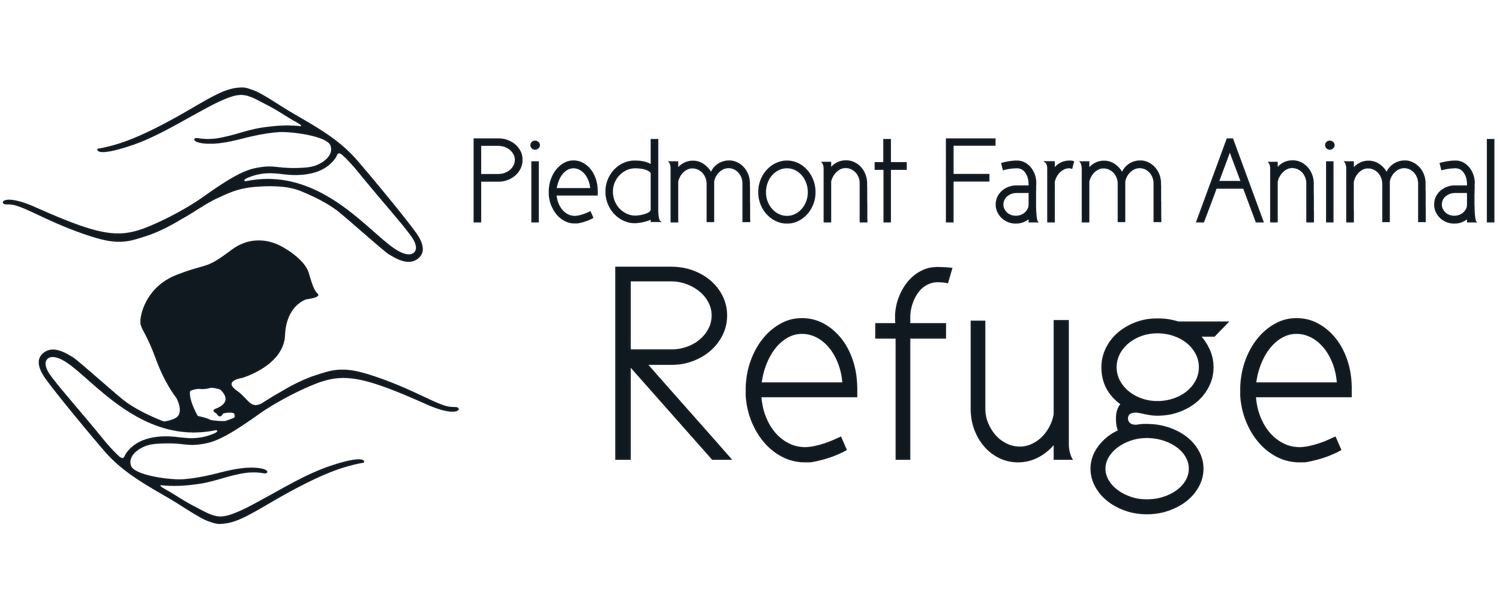Factory Farming: Ducks & Geese
By Barbara Hengstenberg for Piedmont Farm Animal Refuge
We can learn a lot from both ducks and geese. Displaying concern for one another, geese are faithful to their mates and stay close to their sick family members, no matter what. They are cooperative and supportive of one another. In fact, research shows that the V flight pattern helps them to fly more quickly, as they take turns relieving the lead bird when they tire. Their honking is thought to be a sign of encouragement to one another as they fly overhead.
Like geese, ducks are social beings who also develop strong bonds with their flock. They have a sense of humor and habitual routines.
The mistreatment these animals receive in order to harvest their meat, livers, and feathers goes against all the rules of how we, as fellow beings, should treat one another. In the U.S. alone, more than 24 million ducks are killed each year for human consumption. The U.S. processes around 800,000 pounds of duck liver for foie gras (fatty liver) yearly at three facilities: two in New York and one in California. Foie gras, a delicacy to some, is also produced in Belgium, Romania, Spain, France and Hungary.
In a most egregious act of torture, in order to produce this “delicacy,” geese and ducks are confined to cages in dark sheds with hundreds of others and force-fed throughout the day by thrusting a pipe down their throats through which a corn and fat mixture is shoved directly into their gullets. This treatment begins when the birds are only a few months old, and continues for two to four weeks while they become grossly overweight. Once their livers enlarge to ten times the normal size (often also becoming diseased and dysfunctional), the birds are slaughtered. During their confinement, ducks and geese are denied fresh air, freedom of movement and water for bathing. They soon have difficulty breathing, standing and walking.
Their short life on a factory farm is a life of cruelty. Factory farmed ducks quickly become lame and face respiratory problems, eye infections, and feather pecking. Their bills are trimmed to curb such pecking. However, their bill tips contain thousands of sensory receptors, so the bill-trimming process is very painful. Bills are cold-cut with scissors, cut with a hot blade that cauterizes the bill stump, or the tip is seared by holding the bill up to a cauterizing blade — all done without anesthesia. These birds endure painful electric shocks prior to slaughter, and some remain fully conscious when their throats are slit. Some ducks raised for meat are dunked into vats of boiling water in order to remove their feathers after their throats are slit.
Duck and goose feathers are often harvested in order to stuff pillows and coats. One down coat requires the ultimate death of several ducks or geese. Some feathers are live-plucked, requiring the bird to be restrained while their feathers are ripped from their bodies, causing severe pain and lesions. A duck or goose may be plucked for their feathers 3 to 4 times before they are finally slaughtered for their meat.
Four of the duck residents at the Refuge were rescued before being slaughtered for dog food. Upon arrival at the sanctuary, Calliope’s beautiful white feathers were hidden under filth. Holly and Jess have become best friends as they swim, forage, and nap together. And Thomas, a shy duck who arrived with an S-shaped neck due to an injury early in his life, has developed a close bond with his flock. Many of the Refuge duck residents were pets who were abandoned on ponds where they would have starved or died.
At the Refuge, the duck residents are free to live their lives as they were meant to be lived. Sit by one of the duck ponds and watch as they lazily glide upon the water and then, with a quick flip, their heads go under and their butts pop out as they search for food. Or they might be found preening — spreading their natural oils that make their feathers waterproof and keeps them clean.
In August of 2019, three geese arrived at the Refuge after being rescued from severe neglect. They had been living with multiple other species on property with no running water, where mounds of trash littered the landscape. Although they were understandably frightened upon arrival at their new home, they have been patiently soothed and soon began to trust their caregivers. Here at the Refuge, they now have a forever home with a flock of ducks and are living out their lives, gliding and foraging on their new pond.
What can you do to help the ducks and geese who face the horrors of factory farming? Before making purchases, check your clothing and bedding labels, and choose alternatives to duck and goose down. Consider whether the expensive foie gras is worth the horrific means by which these animals suffer. Consider the food you choose for your own plate. There are many plant-based meats on the market today that give us all the ability to make a compassionate decision about what we eat.
Come out to the Refuge and experience the peace of the duck and goose ponds. You will soon find yourself smiling as you watch them chase one another around the pond’s edge. And you will find glee as they joyfully jump into the water and splash about, soon to do their headstand forage with their butts up in the air.
Consider and promote alternatives to the cruel practices of factory farming. Learn more about reducing your consumption of and use of duck and goose products. Share what you’ve learned with others.
Resources:
Bauer, Gene. Farm Sanctuary: Changing Hearts and Minds About Animals and Food. NY: Simon & Schuster, 2008, pp. 198.206.
Hatkoff, Amy. The Inner World of Farm Animals: Their Amazing Social, Emotional, and Intellectual Capacities. NY: Henry N. Abrams, Inc., 2009. pp. 21-41.


